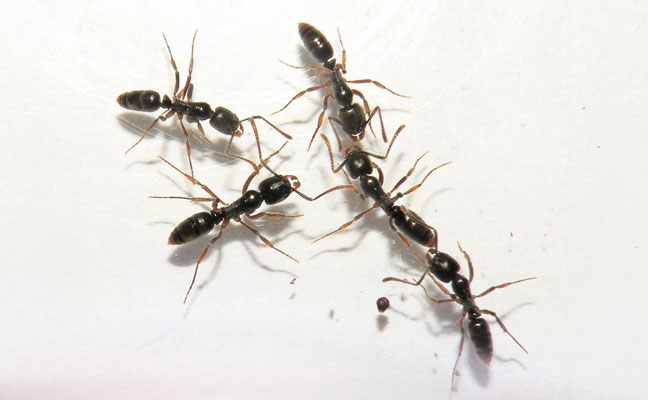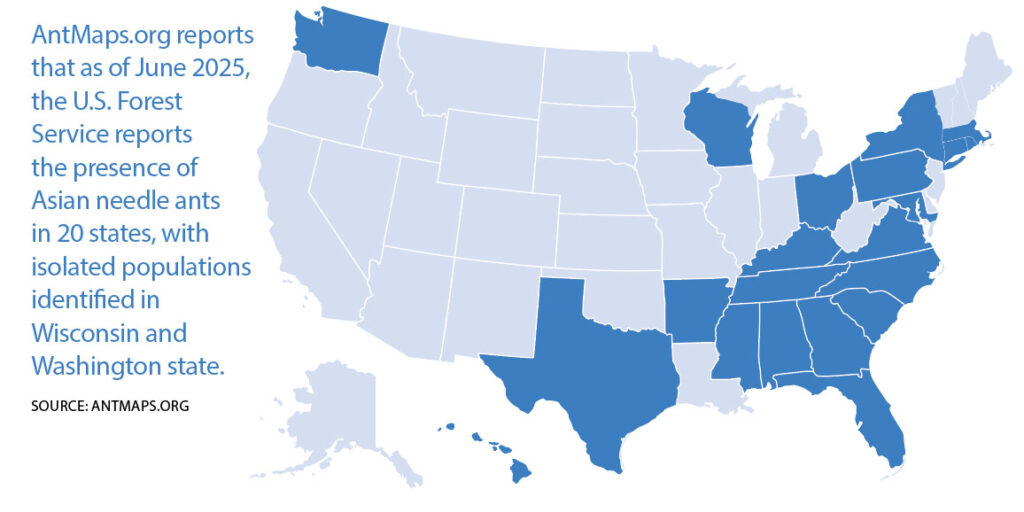
Asian needle ants (Brachyponera chinensis), previously known as Pachycondyla chinensis in many scientific publications until 2014, are not new to the United States. However, there was a recent uptick in news coverage about them in June, especially regarding the unusually painful reactions humans can experience from their stings.
This rise in attention is not due to an increase in their population since their introduction. Instead, it’s primarily because people are spending more time outdoors during summer activities, which increases their likelihood of encountering these ants in their typical habitats: wooded areas and gardens.
This invasive species, in the subfamily Ponerinae, has spread across much of the Southeastern U.S. and into the mid-Atlantic region, reaching as far north as Massachusetts and potentially as far west as Missouri. However, comprehensive research and mapping studies are still needed to confirm the full extent of their distribution.
These ants prefer damp hardwoods for nesting, making them common in moist mulch, fallen trees and logs, under landscaping railroad ties, within leaf litter, under pavers and stones, and in wood piles. While they are not highly aggressive, they will sting to defend their nests.
How Asian needle ants got here
Like odorous house ants (Tapinoma sessile, or OHA) and Argentine ants (Linepithema humile), Asian needle ants are a nonnative species. They arrived in the U.S. as early as the 1930s and have outcompeted native ant species such that they are considered to have a negative impact on the ecological biodiversity of the areas they inhabit.
As their common name implies, Asian needle ants are originally from Japan, Korea and China. And, like several invasive species, they were most likely brought in and spread on nursery and landscaping stock. Their discovery continues in non-arid areas of the southeast and other areas of the U.S.

How to identify Asian needle ants
There is little that is remarkable about how the Asian needle ant looks. With a shiny dark brown to black body, workers are small, measuring 0.12 to 0.25 of an inch in length, while the queen can reach 0.26 of an inch in length.
Identifiable by their light brown antennal tips, legs, mouthparts and stinger, this species primarily consumes small arthropods like termites and springtails, along with other soil and leaf litter invertebrates. Inside structures, they scavenge kitchen and garbage food. While they are drawn to sugar, the ants’ preferred nesting sites typically are near termite colonies, a reliable food source.
These ants have been observed foraging indoors and employ an unusual recruitment method called “adult transport,” where workers physically carry nestmates during emigration. Unlike other ants, they don’t use pheromones for foraging trails, nor do they construct large nests like fire ants, making large groupings of them rare. Many sting victims report not even seeing the ant that stung them.
Although subtle in behavior and appearance, ant stings are potent and more painful than a fire ant’s. The pain reportedly can persist for up to 48 hours, often in waves. Victims may experience skin reactions such as hives, itching and flushed or pale skin. More severe reactions include nausea, dizziness and a rapid pulse, with life-threatening anaphylaxis being the most critical. Immediate medical attention is advised for any reaction to an ant sting.
When to expect Asian needle ants
In the United States, Asian needle ants begin to appear in March as ground temperatures warm and colony sizes grow, peaking in the mid-summer months. This ant can handle cooler temperatures better than most ant species and also survive the winter months at a higher rate. So, an increase in human outdoor activities coincides with the ant population’s growth, accounting for more human interactions.
Asian needle ants have both ecological and medical impacts on their immediate environment. This nonnative ant displaces plant species that depend on native ant species to spread their seeds.
Be proactive
Cooperative extension agents around the country have been receiving an increase in calls for hospitalizations associated with this ant. People who have increased sensitivity to insect stings, up to and including anaphylaxis, need to take all precautions. Advise such customers in areas where Asian needle ants are found to keep antihistamines on hand and carry an epinephrine injection pen when working or playing outdoors.
Also, advise these customers to inspect the potting soil of new plants and shrubs before planting. If any Asian needle ants are found, they should get rid of the infested soil. They also should wear thick work or garden gloves when working in mulch or around wood piles to guard against stings. Cutting up fallen trees into smaller sections will also make the wood less attractive as a nest site.
Asian needle ant colonies are polygynous and polydomous, meaning they have multiple queens and multiple nest sites. Therefore, proper treatment is crucial to prevent budding, which can split the colony and worsen the infestation. Most appropriately labeled professional ant treatment protocols and products, such as granular and gel baits used for OHA and Argentine ants, also are effective against Asian needle ants. Workers will carry the bait back to the colony and share it with their queens, leading to the reduction and elimination of nest sites.
Research for more targeted treatments that minimize the impact on native ant species and the local ecology is ongoing, as the Asian needle ant continues to spread, to establish best management practices.
Dr. Heinsohn is an entomologist at Fulton, Md.-based American Pest, an Anticimex company.
Leave A Comment